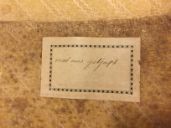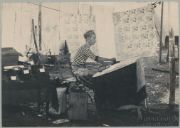‘Met was getjapt’
De eerste doek is met was, bijenwas mogelijk in combinatie met paraffine en hars, voorzien van een patroon. Op een papieren etiket op de achterzijde staat geschreven ‘Met was getjapt’. ‘Getjapt’ verwijst naar het woord ‘tjap’. Een Tjap, tegenwoordig als Cap geschreven, was een koperen stempel die vervaardigd werd op Java in Indonesië. Met een Cap kun je gemakkelijk een herhalend patroon maken op doek met was. Deze techniek was dan ook een welkome uitvinding die gebruikt werd ter vervanging van of aanvulling op de meer tijdrovende Batik Tulis, de ‘handgeschreven’ batik waarbij met een canting, een koperen waspen (lees: was-pen), ‘getekend’ wordt op de stof .
De Cap werd pas echt volop gebruikt toen de eerste imitatiebatiks hun intrede deden halverwege de 19de eeuw. Batik Tulis kon niet concurreren met de deels machinaal vervaardigde imitaties uit Europa, zoals die uit de Leidsche Katoenmaatschappij bijvoorbeeld, maar Batik Cap kon dat wel. Het is dus interessant dat juist de LKM deze serie doeken bezat.


